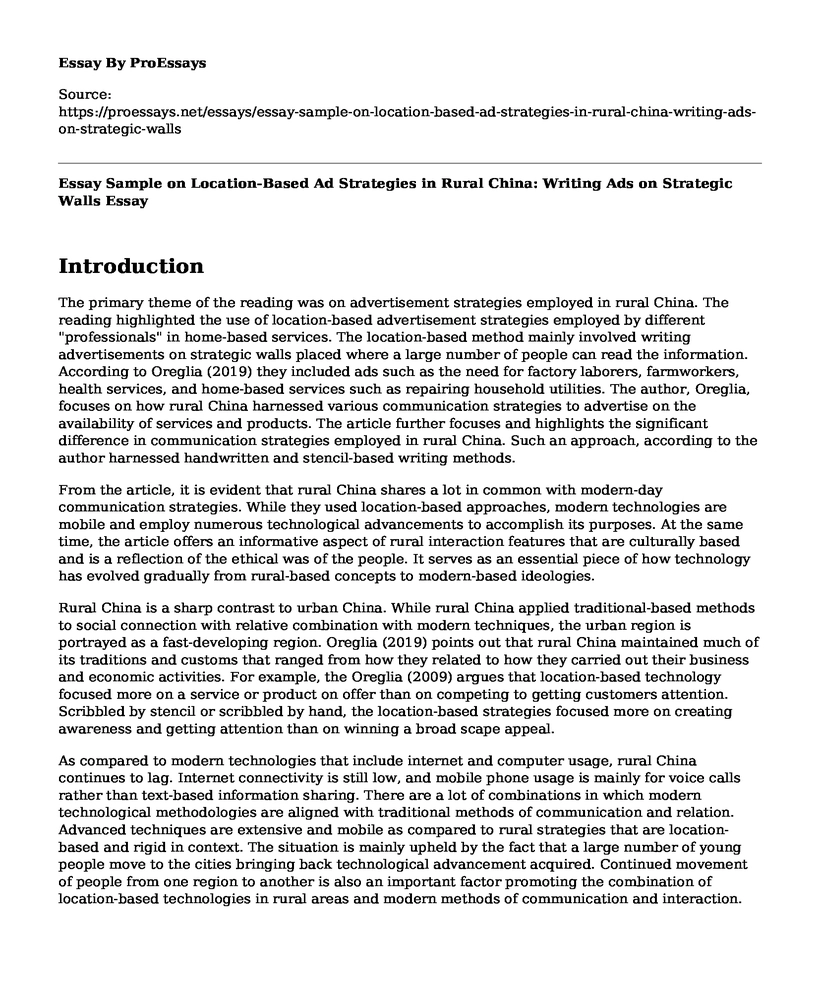Introduction
The primary theme of the reading was on advertisement strategies employed in rural China. The reading highlighted the use of location-based advertisement strategies employed by different "professionals" in home-based services. The location-based method mainly involved writing advertisements on strategic walls placed where a large number of people can read the information. According to Oreglia (2019) they included ads such as the need for factory laborers, farmworkers, health services, and home-based services such as repairing household utilities. The author, Oreglia, focuses on how rural China harnessed various communication strategies to advertise on the availability of services and products. The article further focuses and highlights the significant difference in communication strategies employed in rural China. Such an approach, according to the author harnessed handwritten and stencil-based writing methods.
From the article, it is evident that rural China shares a lot in common with modern-day communication strategies. While they used location-based approaches, modern technologies are mobile and employ numerous technological advancements to accomplish its purposes. At the same time, the article offers an informative aspect of rural interaction features that are culturally based and is a reflection of the ethical was of the people. It serves as an essential piece of how technology has evolved gradually from rural-based concepts to modern-based ideologies.
Rural China is a sharp contrast to urban China. While rural China applied traditional-based methods to social connection with relative combination with modern techniques, the urban region is portrayed as a fast-developing region. Oreglia (2019) points out that rural China maintained much of its traditions and customs that ranged from how they related to how they carried out their business and economic activities. For example, the Oreglia (2009) argues that location-based technology focused more on a service or product on offer than on competing to getting customers attention. Scribbled by stencil or scribbled by hand, the location-based strategies focused more on creating awareness and getting attention than on winning a broad scape appeal.
As compared to modern technologies that include internet and computer usage, rural China continues to lag. Internet connectivity is still low, and mobile phone usage is mainly for voice calls rather than text-based information sharing. There are a lot of combinations in which modern technological methodologies are aligned with traditional methods of communication and relation. Advanced techniques are extensive and mobile as compared to rural strategies that are location-based and rigid in context. The situation is mainly upheld by the fact that a large number of young people move to the cities bringing back technological advancement acquired. Continued movement of people from one region to another is also an important factor promoting the combination of location-based technologies in rural areas and modern methods of communication and interaction.
Conclusion
From the article, several questions come up. What are the main similarities and differences between rural-based communication strategies and modern technological advancements? The two likely share standard features and aspects, especially in harnessing communication approaches and skills. At the same time, it is expected that modern-based communication approaches borrow a lot from location-based technologies as employed and applied in rural China. Another critical question would entail the impact and role of location-based technologies on rural folks in rural China. What could be the impact of location-based technologies on the broader aspect of communication technologies in rural and urban areas in China? How did rural people integrate modern communication technologies with their traditional communication and advisement strategies? The questions would further offer a critical foundation for understanding the value of location-based technologies as employed by the rural populace in rural China. At the same time, discussion and exploration of the questions would further help in understanding the research concepts and ideologies that founded Oreglia's research objective and purpose.
Reference
Oreglia, E. (2019). Location-Based Technologies from the Walls of Rural China. In R. Wilken, G. Goggin, & H. A. Horst (Eds.), Location Technologies in International Context. (Internationalizing Media Studies). Abingdon, Oxon; New York, NY: Rutledge.
Cite this page
Essay Sample on Location-Based Ad Strategies in Rural China: Writing Ads on Strategic Walls. (2023, Feb 12). Retrieved from https://proessays.net/essays/essay-sample-on-location-based-ad-strategies-in-rural-china-writing-ads-on-strategic-walls
If you are the original author of this essay and no longer wish to have it published on the ProEssays website, please click below to request its removal:
- American Foundation for Suicide Prevention Organization Overview
- How Effective Are the Different Sales Promotions in Bel Syry Cesko Limited? - Paper Example
- Article Review on Amazon's New Microwave: 'Alexa, Please Defrost My Chicken'
- Essay Sample on Supplying Fast Fashion: Evaluating the Design Stage of the Supply Chain
- Essay Sample on Save the Children Organization: Giving Hope to the Future of the World
- Essay Example on Coca-Cola: The Iconic Brand of Non-Alcoholic Beverages
- Essay Example on Identifying Population Need: Adult Services in Organizations







